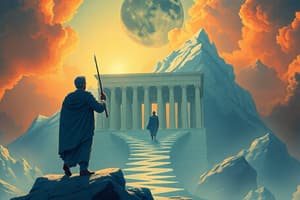Podcast
Questions and Answers
What is totalitarianism?
What is totalitarianism?
- An economic system
- A system of checks and balances
- Government that takes control (correct)
- A type of democracy
What do totalitarianism leaders often utilize to create fear?
What do totalitarianism leaders often utilize to create fear?
Secret police
What are the methods used by totalitarianism leaders?
What are the methods used by totalitarianism leaders?
Terror, indoctrination, propaganda, censorship, religious or ethnic persecution
What is police terror?
What is police terror?
Define indoctrination.
Define indoctrination.
What is the function of propaganda and censorship in totalitarianism?
What is the function of propaganda and censorship in totalitarianism?
What groups are often scapegoated during religious or ethnic persecution?
What groups are often scapegoated during religious or ethnic persecution?
What was Stalin's plan for the Soviet Union?
What was Stalin's plan for the Soviet Union?
What characterized Stalin's police state?
What characterized Stalin's police state?
What was the Great Purge?
What was the Great Purge?
How did Stalin's government control information?
How did Stalin's government control information?
What was the goal of education under Stalin?
What was the goal of education under Stalin?
What was the League of the Militant Goddess?
What was the League of the Militant Goddess?
What is a command economy?
What is a command economy?
What were the Five-Year Plans aimed at?
What were the Five-Year Plans aimed at?
What were collective farms?
What were collective farms?
Who were the kulaks?
Who were the kulaks?
What are state farms?
What are state farms?
What were some benefits of Stalin's rule?
What were some benefits of Stalin's rule?
What were some costs of Stalin's rule?
What were some costs of Stalin's rule?
What was the outcome of the Bolshevik Revolution of 1917 regarding gender equality?
What was the outcome of the Bolshevik Revolution of 1917 regarding gender equality?
What changes occurred in women's roles during Stalin's rule?
What changes occurred in women's roles during Stalin's rule?
Flashcards are hidden until you start studying
Study Notes
Totalitarianism Overview
- Totalitarianism involves a government that centralizes control over all aspects of public and private life.
- Leaders appear to provide security and direction but often utilize secret police to suppress opposition and instill fear.
Methods of Control
- Common methods used by totalitarian leaders include terror, indoctrination, propaganda, censorship, and religious or ethnic persecution.
- Police serve to enforce government policies; their role includes spying on citizens and using brutal force.
Indoctrination and Education
- Indoctrination shapes public perception through controlled education that glorifies the government.
- Schools are used to instill the virtues of the Communist Party, with any opposing views leading to dismissal or arrest.
Propaganda and Censorship
- The government employs propaganda to sway public beliefs, controlling all mass media under strict censorship.
- Disseminating dissenting information is categorized as treason, leading to severe punishment.
Persecution of Minorities
- Religious and ethnic groups often serve as scapegoats during crises, facing violence and terror targeted at their identity.
Stalin's Regime
- Stalin aimed to establish a totalitarian state, creating the ideal Communist society in the Soviet Union.
- The secret police used military vehicles to quash riots and monitored citizens extensively, resulting in the arrest and execution of millions.
The Great Purge
- The Great Purge in 1937 targeted perceived threats to Stalin's power, resulting in 8 to 13 million deaths through execution or labor camps.
Economic Policies
- Stalin initiated a command economy in 1928 where the government dictated all economic decisions.
- The Five-Year Plans set high production goals for industrial output but led to shortages of consumer goods.
Agriculture and Resistance
- Collective farms were created by merging privately owned farms, leading to widespread resistance among peasants, especially wealthy kulaks.
- State farms operated like factories, paying workers wages, but faced challenges due to agricultural difficulties.
Social Impact of Stalin's Rule
- Women's roles expanded, contributing significantly to the workforce and achieving equality in many professions.
- Educational opportunities improved, allowing people to gain technical skills; however, personal freedoms were curtailed, and consumer goods remained scarce.
Historical Context
- The Bolshevik Revolution of 1917 set a foundation for gender equality by declaring men and women equal in rights.
- Despite advancements for women, the regime's oppressive elements continued to dominate public life.
Studying That Suits You
Use AI to generate personalized quizzes and flashcards to suit your learning preferences.




